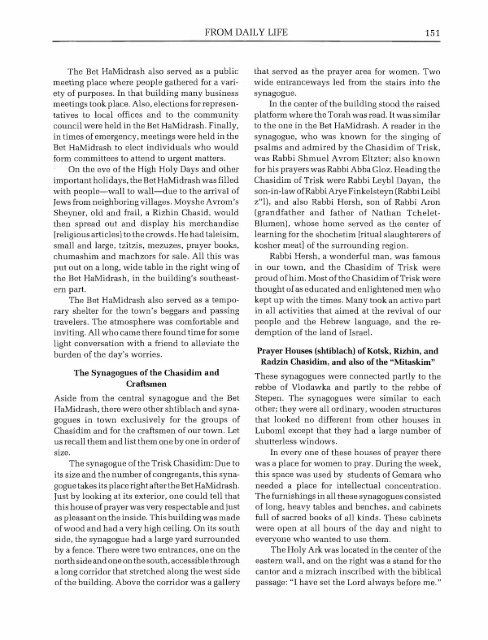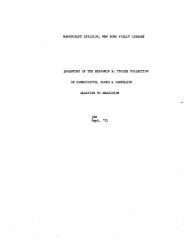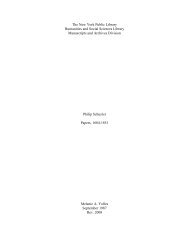pdf available - Multiple Choices
pdf available - Multiple Choices
pdf available - Multiple Choices
You also want an ePaper? Increase the reach of your titles
YUMPU automatically turns print PDFs into web optimized ePapers that Google loves.
The Bet HaMidrash also served as a public<br />
meeting place where people gathered for a variety<br />
of purposes. In that building many business<br />
meetings took place. Also, elections for representatives<br />
to local offices and to the community<br />
council were held in the Bet HaMidrash. Finally,<br />
in times of emergency, meetings were held in the<br />
Bet HaMidrash to elect individuals who would<br />
form committees to attend to urgent matters.<br />
On the eve of the High Holy Days and other<br />
important holidays, the Bet HaMidrash was filled<br />
with peoplewall to walldue to the arrival of<br />
Jews from neighboring villages. Moyshe Avrom's<br />
Sheyner, old and frail, a Rizhin Chasid, would<br />
then spread out and display his merchandise<br />
[religious articles] to the crowds. He had taleisim,<br />
small and large, tzitzis, mezuzes, prayer books,<br />
chumashim and machzors for sale. All this was<br />
put out on a long, wide table in the right wing of<br />
the Bet HaMidrash, in the building's southeastern<br />
part.<br />
The Bet HaMidrash also served as a temporary<br />
shelter for the town's beggars and passing<br />
travelers. The atmosphere was comfortable and<br />
inviting. All who came there found time for some<br />
light conversation with a friend to alleviate the<br />
burden of the day's worries.<br />
The Synagogues of the Chasidim and<br />
Craftsmen<br />
Aside from the central synagogue and the Bet<br />
HaMidrash, there were other shtiblach and synagogues<br />
in town exclusively for the groups of<br />
Chasidim and for the craftsmen of our town. Let<br />
us recall them and list them one by one in order of<br />
size.<br />
The synagogue of the Trisk Chasidim: Due to<br />
its size and the number of congregants, this synagogue<br />
takes its place right after the Bet HaMidrash.<br />
Just by looking at its exterior, one could tell that<br />
this house of prayer was very respectable and just<br />
as pleasant on the inside. This building was made<br />
of wood and had a very high ceiling. On its south<br />
side, the synagogue had a large yard surrounded<br />
by a fence. There were two entrances, one on the<br />
north side and one on the south, accessible through<br />
a long corridor that stretched along the west side<br />
of the building. Above the corridor was a gallery<br />
FROM DAILY LIFE 151<br />
that served as the prayer area for women. Two<br />
wide entranceways led from the stairs into the<br />
synagogue.<br />
In the center of the building stood the raised<br />
platform where the Torah was read. It was similar<br />
to the one in the Bet HaMidrash. A reader in the<br />
synagogue, who was known for the singing of<br />
psalms and admired by the Chasidim of Trisk,<br />
was Rabbi Shmuel Avrom Eltzter; also known<br />
for his prayers was Rabbi Abba Gloz. Heading the<br />
Chasidim of Trisk were Rabbi Leybl Dayan, the<br />
son-in-law of Rabbi Arye Finkelsteyn (Rabbi Leibl<br />
z"1), and also Rabbi Hersh, son of Rabbi Aron<br />
(grandfather and father of Nathan Tchelet-<br />
Blumen), whose home served as the center of<br />
learning for the shochetim [ritual slaughterers of<br />
kosher meat] of the surrounding region.<br />
Rabbi Hersh, a wonderful man, was famous<br />
in our town, and the Chasidim of Trisk were<br />
proud of him. Most of the Chasidim of Trisk were<br />
thought of as educated and enlightened men who<br />
kept up with the times. Many took an active part<br />
in all activities that aimed at the revival of our<br />
people and the Hebrew language, and the redemption<br />
of the land of Israel.<br />
Prayer Houses (shtiblach) of Kotsk, Rizhin, and<br />
Radzin Chasidim, and also of the "Mitaskim"<br />
These synagogues were connected partly to the<br />
rebbe of Vlodawka and partly to the rebbe of<br />
Stepen. The synagogues were similar to each<br />
other; they were all ordinary, wooden structures<br />
that looked no different from other houses in<br />
Luboml except that they had a large number of<br />
shutterless windows.<br />
In every one of these houses of prayer there<br />
was a place for women to pray. During the week,<br />
this space was used by students of Gemara who<br />
needed a place for intellectual concentration.<br />
The furnishings in all these synagogues consisted<br />
of long, heavy tables and benches, and cabinets<br />
full of sacred books of all kinds. These cabinets<br />
were open at all hours of the day and night to<br />
everyone who wanted to use them.<br />
The Holy Ark was located in the center of the<br />
eastern wall, and on the right was a stand for the<br />
cantor and a mizrach inscribed with the biblical<br />
passage: "I have set the Lord always before me."







